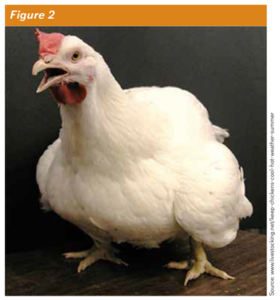Heat Stress In Poultry
Click here to view as a pdf: Heat Stress In Poultry
By Stephanie Hutsko, PhD
Simply put, heat stress occurs when a bird’s core temperature is higher than its thermoneutral zone (Figure 1). A thermoneutral zone is a temperature range in which an animal does not use any additional energy to maintain its normal core body temperature. Heat stress is a result of a negative balance between the energy transfer from the bird’s body to its environment and the amount of heat energy produced by the bird. This imbalance can be caused by multiple factors such as ambient temperature, humidity, air movement, metabolism rate and thermal irradiation. Effects can range from mild distress to death.

Modern poultry breeds may produce more body heat due to increased metabolic activity and as a result, are more susceptible to heat stress. To give some perspective, an average adult male human produces 1/7th of the heat per kg of body weight that a modern broiler produces. Birds are not able to combat heat through perspiration on the skin and only lose about 40% of the heat that they produce to the surrounding air. Birds do, however, have a unique heat abatement method involving air sacs. Air sacs promote air circulation, which in turn increases the evaporative loss of heat from the respiratory system. The physical manifestation of this process is panting (Figure 2).
How To Tell If Birds Are Heat Stressed
As mentioned above, panting is a solid indicator that birds are experiencing heat stress, but there are other signs to look for, too. One of the first signs commonly noticed is a decrease in feed intake paired with an increase in water intake. Birds that are heat stressed may spread their wings to increase airflow and are often more sedentary.
When dealing with laying hens, egg production will decrease along with egg quality parameters, such as eggshell thickness, egg weights and Haugh unit measurements1. If the hens produce brown eggs, the shell color will become paler. Broilers will show a decrease in body weight gain and feed conversion. Birds that have experienced heat stress have lower meat quality when processed, showing lower percent protein and higher inclusion of fat in the breast muscle, as well as a decrease in overall breast muscle weight.
The physiological effects on the birds are sometimes hidden but are just as detrimental to performance and health. During any time of stress, the hormone cortisol is elevated to help the body cope initially, but as time passes and the cortisol levels remain high, the hormone will start to have negative effects on immune and digestive function. Antibody production and response become significantly depressed, making birds more susceptible to illness2. In addition to an impaired immune system, birds experiencing heat stress will also face a compromised gastrointestinal system. Birds subjected to heat stress have been shown to have decreased dietary digestibility and decreased plasma protein and calcium levels3,4. When birds pant, there is a subsequent increase in carbon dioxide and blood pH, which in turn decreases the blood bicarbonate that is available for eggshell formation.
What Can Be Done To Alleviate Heat Stress?
Heat stress leads to annual economic losses of $128 to $165 million in the poultry industry5. Providing proper ventilation and using cooling pads can help alleviate heat stress in the birds’ housing environment. During hot weather, adequate airspeeds can be accomplished through the use of fans and tunnel ventilation. It is important that humidity levels are kept low. If humidity reaches a high enough level it can become detrimental to the birds’ ability to regulate their body temperature. For every 10% increase in relative humidity, a bird’s thermoneutral zone decreases by one to two degrees Celsius. During times of extreme heat, misters and cooling fans may also be beneficial to promote evaporative cooling.
There are two effective nutritional strategies that can be used to lessen the effects of heat stress in birds. They include increasing the nutrient density of the diet and focusing on immune support. The nutrient density of the diet may be increased to offset the decreased intake that occurs during hot weather. Birds need to be provided with adequate amounts of antioxidants, vitamins and trace minerals regardless of stress status. Minerals and vitamins can become more critical in times of stress as the immune system has a high requirement for them to function properly. Immune supportive feed additives can also be included in the diet to combat the negative effects of heat stress. Crystal Creek® developed Crystal Meal™ specifically for this purpose. This aloe-based feed additive allows the immune system and gastrointestinal tract to function at normal capacity even in the presence of stress hormones. This allows the birds to maintain production and meat/egg quality.
Overall, modern-day chickens are more susceptible to heat stress than their jungle fowl ancestors. Genetic selection and housing have drastically changed the way birds are raised and managed. Therefore, measures need to be taken to ensure that they are provided with adequate heat abatement practices, such as effective ventilation and airflow, immune supportive therapies and proper nutrition. Crystal Creek® employs experts that are available to help with any questions or concerns you may have about heat stress in poultry. Give us a call today.
